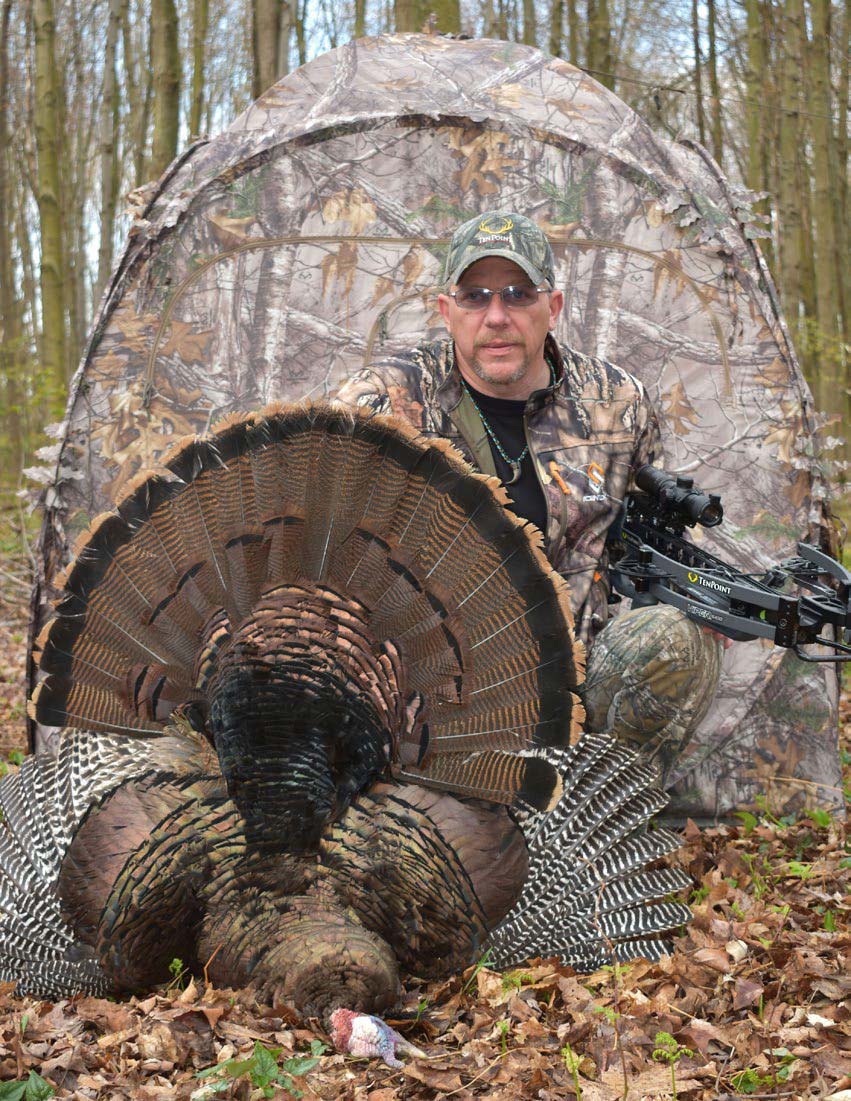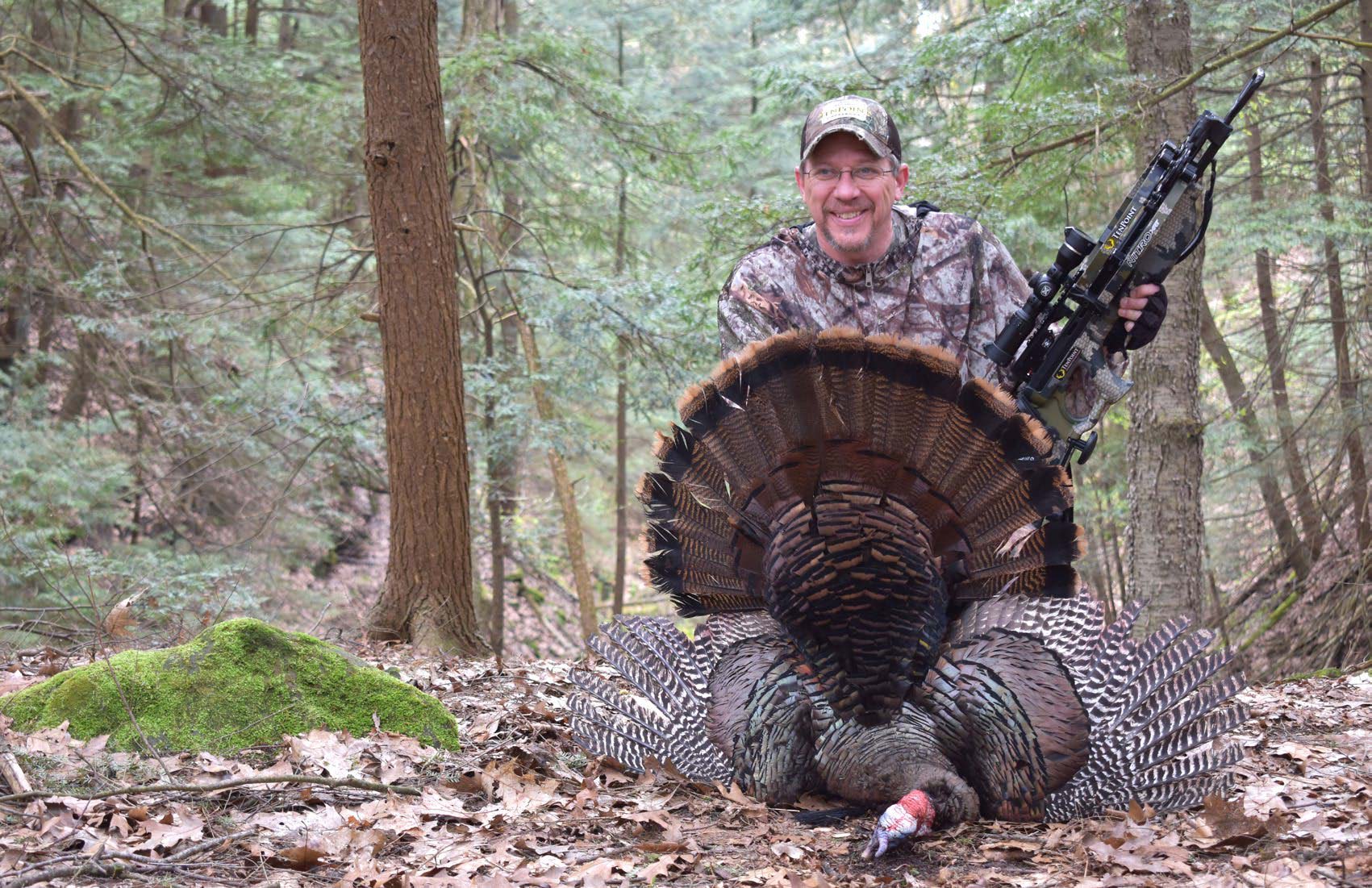Spring gobbler season is one of my favorite times of the year. After months of domestic blissfulness with no hunting activity, spring gobbler season kicks off the start of the new hunting year. It’s also the first opportunity to field test many of the new bowhunting products on the market. Each year more and more hunters take to the spring woods with archery equipment in hand. Having successfully pursued spring gobblers with stick and string for many years, I will attempt to outline what I believe are the most important factors contributing to that success. Hopefully, one or more of these tactics will be something you can incorporate into your own turkey hunting routine.
Preparation = Success
Bowhunting spring gobblers is a completely different ballgame from hunting them with a shotgun. Your preparation needs to begin weeks, if not months, in advance of the season and should begin with your equipment. When I’m setting up my bow for a turkey hunt, my two biggest concerns are arrow weight and broadhead preference. Since most hunters have their bows set up with the whitetail in mind, we’ll use this as our comparison point.
I prefer to shoot an arrow that is 100 grains lighter for my turkey setup. There are several reasons for this logic. A turkey’s kill zone is about the size of a softball. And unlike a whitetail, rarely can you get a turkey to pose in a stationary position. A lighter arrow will shoot faster and flatter than a heavier arrow. Penetration is also an important factor to consider. Unlike the whitetail, we do not want the arrow to fully penetrate and pass through the wild turkey. A lighter arrow will penetrate less than a heavier one.
Selecting the proper broadhead is also a critical part of your equipment preparation. After shooting turkeys with nearly every broadhead style available: fixed blade, expandable, cut on contact, replaceable blade, etc., I’m a firm believer that the most effective broadheads available to turkey hunters are the ones designed specifically for turkeys. When used in conjunction with a lighter weight arrow, the open fixed blade design of the turkey specific broadheads will not only hinder penetration but also transfer a tremendous amount of shock through the intended target upon impact.

Locate Don’t Educate
After your equipment choices have been made and you’ve become deadly proficient with your setup, the next step is to locate not one but several mature gobblers to target. The most effective way that I’ve found to do this is by driving country roads in the mornings and evenings, glassing open fields. If you have access to secluded fields not visible from the highway, that’s even better. I’m not opposed to hunting deep woods or mountain top gobblers, but my preference is to hunt the more visible field gobblers. During any given season, I can locate between fifteen and twenty different gobblers using this technique. Often times mature gobblers will spend hours with their hens strutting, gobbling and breeding right out in the fields.
Many times they will use the exact same entrance and exit points when utilizing the fields. After two or three quick glassing sessions, you can have the birds relatively patterned and you’ve not educated them in the least. Simply set up on the field edge in the predawn darkness and wait for the gobbler to make his appearance. After a few series of calls, more often than not, he’ll be right in your lap.
It’s important to locate as many gobblers as possible when taking this approach. You must assume that other hunters have also seen the gobbler and will be hunting him. Because of the birds’ high visibility, other predators will also be targeting the area. You’ll lose some of the gobblers to the competition; but when you have multiple birds located, you’ll take your fair share with this approach as well.
Caller ID
Spring gobblers can be fickle creatures. When they’re ready to die, there is absolutely no mistake one can make that will dissuade them from their suicidal advance. However, more often than not, they’ll hang up outside of crossbow range refusing to commit until they’re confident with the situation. Carrying a variety of calls and identifying the call that elicits the best response from the gobbler will often times be the difference between success and failure.
A perfect example of this took place a few years ago when I was set up on a hemlock ridge the opening week of Pennsylvania’s spring gobbler season. On that day I would be filming on the camera and call for another hunter. As dawn approached, two distinct gobblers were cutting loose approximately a hundred and fifty yards from our position. Since we were filming and using a blind this day, we elected to stay put and try to work the gobblers to our position. I had a variety of diaphragm calls in my arsenal and would regularly throw a string of yelps, clucks and cuts in the gobblers’ direction. Occasionally, I could entice a response; but it was clearly evident the gobblers had no intention of heading our way.
My hunting partner, who was obviously impressed with my turkey calling talents, pulled out a box call two hours into my serenade and sent a series of yelps down the ridge. The woods literally exploded with turkey talk. Within fifteen minutes he had not one but five different gobblers standing in front of the blind well within bow range. When it was all said and done, he was affixing his tag to the dominant longbeard of the bunch. By simply adding another call to the mix, what surely would’ve turned out to be a frustrating morning, turned into a very successful one.
I’ve since taken my call selection to the next level. Not only do I carry multiple calls, but I try to stay away from the commercially made ones as well. My theory is if the local WalMart is selling fifty or more of the same calls, there’s a good chance the local gobbler population has already heard that tone and pitch several times before. I’ve since switched to custom made calls. Not only is there less chance of a gobbler having heard the call, to my ear they sound a whole lot better than the commercially made ones.
Deer Hunting Turkeys
For some reason hunters understand the importance of preseason scouting for whitetails, but feel it’s not necessary to commit to that same level of preparation when hunting turkeys. Perhaps it’s due in part to spring gobblers being vocal? However, knowing a bird is in the local vicinity and killing it are two completely different things. Wild turkeys can be very predictable and patternable. Gobblers are more reclusive and nomadic than hens; but during the spring season, gobblers will have their breeding territories established and will be spending their time there. Most of your scouting can be done from afar by listening for gobblers to sound off in their roosting areas in both the mornings and evenings. Even as the season progresses, they will traverse ridge lines, cross streams, roost and feed in the same general areas.
Turkeys as a whole do not travel very far or fast in the spring time. There’s plenty of abundant food sources. Hens won’t stray far from established dusting and nesting sites, and gobblers are reluctant to leave their established breeding area. On more than one occasion I’ve seen a gobbler with several hens stay within a two-hundred yard radius the entire day. Scouting and laying out a well-planned point of attack can be easily executed on turkeys just like it’s done on whitetails. I like to take the approach that calling, decoying, and moving are not an option. My goal is to kill the gobbler from one setup with the bow as my only tool. When you’ve accomplished this level of consistency with your scouting and then add the extra tactics at your disposal i.e. calling and decoys, you’ll be a much more proficient turkey hunter.
Dupe Them With Deke’s
I always incorporate three or more decoys into my setups. If you’ve scouted your area properly, a wary old gobbler will often times cover those last few fatal yards if he spots decoys in an area where he typically expects to see other turkeys. The decoys will divert his focal point from the shooter. Decoys also give the bow hunter an instant yardage reference point. It’s important that you know the exact distance to your decoys so you can estimate the yardage accordingly before you take the shot at an approaching gobbler.
There are several styles and models of decoys available. I prefer to use a feeding hen, alert hen and full strut gobbler decoy in my setups. Generally, if a gobbler is approaching a hen decoy, he will do so from the rear. If he’s approaching a full strut gobbler decoy, he will typically do so from the side or front. Try to stake out your decoys accordingly in reference to the anticipated approach of the incoming gobbler.
The turkey decoy industry has improved greatly over the past few decades. There are some tremendously lifelike decoys currently available on the market. For whatever reason some are more effective than others. For my money the absolute best turkey decoys on the market are real taxidermy created decoys. Lifelike decoys should be a part of every turkey hunter’s arsenal.
Butt Shoot Them
Having hunted the wild turkey with archery equipment for four decades, I’m a stickler about proper shot placement. Rarely does a turkey stay stationary for any extended period, and they have absolutely no curiosity. At the blink of an eye they may instantly be running for the next county. And if that doesn’t get them there fast enough, they’ll take to the air. They also have a relatively small vital zone, leaving little room for error. For this reason I believe there is only one ethical shot to take at a turkey when using archery equipment.
If complete recovery of the turkey is your goal and a crippling loss is not an option, then the only shot you should ever take is the broadside or nearly broadside wingbutt shot. The wingbutt shot provides the largest exposure to the vital area and also affords you the opportunity to incapacitate the turkey by breaking its wing. A wingbutt shot gobbler will generally expire within sight if not immediately upon impact. There’s simply too much room for error when targeting other areas. If your shot placement is off by as little as one inch, the turkey can escape recovery.
If you think you’re up for the additional challenge this spring, hopefully one or more of these tips will help you enjoy a successful season. Bowunting spring gobblers is about as challenging and as fun as it gets. Good luck!
By Todd Bromley
Per our affiliate disclosure, we may earn revenue from the products available on this page. To learn more about how we test gear, click here.








